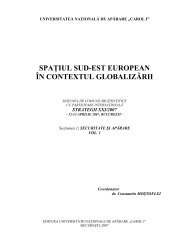Impact strategic nr.6-7 - Centrul de Studii Strategice de Apărare şi ...
Impact strategic nr.6-7 - Centrul de Studii Strategice de Apărare şi ...
Impact strategic nr.6-7 - Centrul de Studii Strategice de Apărare şi ...
- No tags were found...
Create successful ePaper yourself
Turn your PDF publications into a flip-book with our unique Google optimized e-Paper software.
ACTUALITATEA POLITICO-MILITARĂ<br />
the necessary forces. For a good functioning, conscription<br />
needs only a legitimate framework but the professional<br />
army has to respect the labor market conditions, being<br />
influenced by its fluctuations. The job offers in civilian<br />
field, mainly in the private one, is not in concordance with<br />
the offer while the army jobs are now safer and apparently<br />
better paid. Meantime, in this case, a significant negative<br />
influence has the <strong>de</strong>mographic factor. Usually an army<br />
needs certain population samples, the one aged between<br />
20 and 25. But on every generation 15-20% of the young<br />
people are unfit for conscription, from physical, psychical<br />
causes. From here <strong>de</strong>rive some difficulties in recruitment<br />
process. There must be taken into account the <strong>de</strong>crease of<br />
the population. We stress out the increase of the number<br />
of women in the army, as officers and NCOs especially.<br />
As western military specialists assert, “the success <strong>de</strong>pends,<br />
above all, on people”. That means in selecting<br />
and training the professional soldiers and reservists there<br />
have to be taken into consi<strong>de</strong>ration the following aspects:<br />
recruiting and maintaining in the military structures the<br />
best persons, no matter the nationality and religion; their<br />
training, motivation and the a<strong>de</strong>quate equipping so that<br />
their option for choosing a military career to be sustained<br />
with plausible arguments; establishing career routes that<br />
will offer a clear perspective on satisfying the individual<br />
professional aspirations and their families’ expectations;<br />
3) the effects on the army’s structure. The transition to a<br />
professionalized army requires some structural changes.<br />
The first one implies a <strong>de</strong>crease of land forces, one that<br />
is both a cause and an effect: cause – if conscription<br />
is eliminated, there will be a <strong>de</strong>crease in needs of the<br />
land forces and effect – the constant budgetary raise per<br />
soldier limits the theoretical level of forces and because<br />
these forces have the biggest difficulties in recruiting. A<br />
second change of the military landscape comes from the<br />
first one. Replacing people with better fight means, the<br />
land forces use a smaller number of soldiers, on strictly<br />
<strong>de</strong>fined job positions. A third effect refers to a process of<br />
aging the military population, as a result of increasing the<br />
career personnel and passing to a high technological army.<br />
A fourth change of structure refers to the increase of the<br />
proportion of the people with low salaries. These persons<br />
will easier accept the firing conditions; 4) institutional<br />
impact. The more subtle and less perceived changes are<br />
those ones referring to the military institutions. In a professional<br />
army it is likely to appear two different military<br />
categories: the combatants – consistent of <strong>de</strong>fending the<br />
military values and “technicians” that consi<strong>de</strong>r themselves<br />
more specialists than soldiers. On the other hand, the<br />
professionalized military personnel endure the family’s<br />
pressure that compares the living conditions with the ones<br />
working in the private sector; 5) the relation army-society.<br />
In time, a professionalized army may lead to a <strong>de</strong>crease in<br />
the <strong>de</strong>fense spirit of the country’s citizens, a <strong>de</strong>crease in<br />
interest for the military profession. The military service<br />
will be consi<strong>de</strong>red a profession, like many others, and<br />
extensively the military institution – being similar to any<br />
“factory”. If the service military is performed just by a<br />
part f the population, the perception on this institution<br />
will not be any longer as strongly positive as it is now.<br />
The army’s image will be strengthened by participating<br />
to external missions with some military structures as an<br />
institution with specific tasks.<br />
The professionalization of Romania’s Armed Forces,<br />
in the context of integrating in Euro-Atlantic structures,<br />
is a necessity and a sine qua non of its compatibility and<br />
interoperability with the other NATO’s member armies.<br />
The main coordinates and parameters of the process of<br />
building a national army, compatible and interoperable<br />
with the other armies from NATO are mentioned in the<br />
white papers of Romania’s Government.<br />
26 IMPACT STRATEGIC nr. 1-2/2003





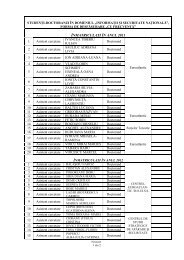
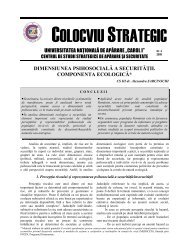
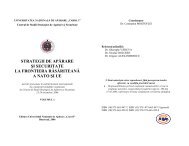
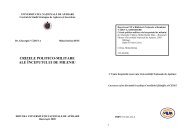


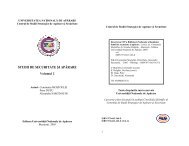

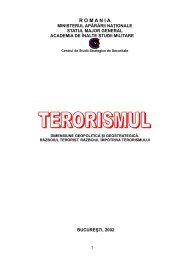
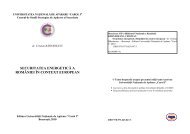
![„CAROL Nr 4 [29]/2008](https://img.yumpu.com/53801719/1/184x260/carol-nr-4-29-2008.jpg?quality=85)
